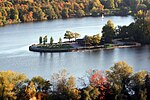Hofen (Stuttgart)
|
Hofen district of Stuttgart |
|
|---|---|
| Coordinates | 48 ° 50 '10 " N , 9 ° 13' 30" E |
| surface | 2.30 km² |
| Residents | 4193 (May 31, 2020) |
| Population density | 1823 inhabitants / km² |
| Incorporation | Jul 1, 1929 |
| Post Code | 70378 |
| prefix | 0711 |
| Borough | Mulhouse |
| Source: Data Compass Stuttgart (PDF) | |
Hofen is a district of the Baden-Württemberg state capital Stuttgart , located on the Neckar , in the northern district of Mühlhausen .
history

Hofen was first mentioned in a document in 1120, since 1753 it has belonged (again) to Württemberg , and in 1929 it was incorporated into Stuttgart . Then Hofen was run as a district. On February 1, 1952, the Hofen district, which had previously belonged to the Bad Cannstatt district, was assigned to the Mühlhausen district. When dividing the city of Stuttgart in municipalities in 1956, the district Hofen was with the neighboring district of Mulhouse to the municipality Mulhouse united, to the 1964 nor the district Mönchfeld , 1973, the district of Freiberg and 1971 the district Neugereut came. The latter belonged to the court earlier. The Steinhaldenfeld district , which also previously belonged to Hofen, with the main cemetery in Stuttgart is now part of the Bad Cannstatt district .
Since Hofen belonged to the Counts of Neuhausen during the Reformation , it remained Catholic together with the neighboring Oeffingen (now part of Fellbach ) and the communities of Justingen and Ebersberg, in contrast to the other Württemberg communities (according to § 31 of the Osnabrück Peace, "normal year 1624") .
Hofen flourished briefly at the end of the 18th century under Duke Carl Eugen .
Attractions
The Castle Hofen was probably built in the 13th century, the castle was destroyed in the Thirty Years' War and is a ruin on the Neckar River. It served to secure the Neckar ford to Mühlhausen.
The Catholic Church of St. Barbara was built in 1783/84. A large part of the facility came to Hofen in 1810 from the Franciscan monastery in Oeffingen, which had been closed five years earlier. Pilgrimages to the Stuttgart Madonna , which was brought to Hofen by the last Catholic priest of the Stuttgart collegiate church in 1535, have been organized since 1954 . According to legend, when he wanted to leave the church, she called out to him: "Take me with you, and my divine Son!"
Max-Eyth-See
The Max-Eyth-See was created in 1935 after gravel had been extracted in the Neckar valley and a barrage had been built as a result of the Neckar canal. Until 1942, part of the lake area was used as a public outdoor pool.
After the Second World War, the lake was partially filled with rubble from the buildings destroyed in the war. Sailing regattas were held several times, including motorboat races in 1953 and 1954 . In 1961 the lake was declared a landscape protection area, after which numerous water bird species have settled there. The body of water and its immediate surroundings have become a popular local recreation area in Stuttgart.
Events
Events with significance beyond the city district are / were:
- Carnival parade through the streets of Hofen on Shrove Tuesday.
- Summer festival of the Musikverein Stuttgart-Hofen in 1905 on the festival meadow from Corpus Christi until the following Monday.
- SWR3 Seefest at Max-Eyth-See, in support of the Christoph Sonntag environmental initiative “The Max-Eyth-See should become cleaner”. However, this should not be continued due to organizational problems.
Buildings on the Neckar near Hofen
The Hofen barrage has been in the Neckar since the river was made navigable .
Honorary citizen
- In 1924 Pastor Adolf Adis (1873–1963) was made an honorary citizen.
Web links
- www.stuttgart.de
- Max-Eyth-See - once a gravel pit, today a protected area
- District blog Nördliches-Stuttgart.DE for the districts of Mühlhausen, Münster, Stammheim and Zuffenhausen






